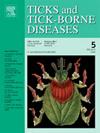边缘无原体调节参与病原体传播的微型鼻多头器官的微生物群
IF 3.4
2区 医学
Q2 INFECTIOUS DISEASES
引用次数: 0
摘要
牛蜱微型鼻头虫是世界热带和亚热带地区边缘性无形体病媒。在蜱器官尺度上研究病原体-微生物组-媒介相互作用是一个有前途的发展领域,揭示了蜱传疾病的控制策略。我们的研究主要集中在边缘芽孢杆菌感染如何影响小毛鼠唾液腺和卵巢内的细菌群落。在阿根廷某疾病流行区采集的牛身上采集的雌性蜱虫,通过组织样本的PCR诊断,以msp1β基因为靶点,进一步对其是否感染边缘蜱进行分类。我们在整个研究过程中纳入了阴性对照样本。我们通过测序16S rRNA V3-V4区分析蜱组织细菌群落。我们的结果显示感染和未感染样本之间的群落组成有显著差异。Sphingomonadaceae是未感染的唾液腺和卵巢的优势分类群。此外,我们构建了共生网络来研究微生物群落内部的相互作用。值得注意的是,边缘芽孢杆菌感染导致唾液腺网络复杂性增加,对卵巢产生相反的影响。这些发现强化了一种假设,即边缘拟南芥在器官特异性水平上影响微加罗汉菌的微生物群。本文章由计算机程序翻译,如有差异,请以英文原文为准。
Anaplasma marginale modulates the microbiota of Rhipicephalus microplus organs involved in pathogen transmission
The cattle tick Rhipicephalus microplus is a vector for Anaplasma marginale in tropical and subtropical regions worldwide. The study of pathogen-microbiome-vector interactions at the tick organ scale is a promising area of development, unraveling control strategies for tick-borne diseases. Our study focused on how A. marginale infection affects the bacterial community within the salivary glands and ovaries of R. microplus. Engorged female ticks collected from cattle in a disease-endemic area of Argentina were further classified based on whether they were infected with A. marginale by targeting the msp1β gene through PCR diagnosis in tissue samples. We included negative control samples throughout the study. We analyzed the bacterial communities in tick tissues by sequencing the 16S rRNA V3-V4 region. Our results revealed significant differences in community composition between infected and uninfected samples. Sphingomonadaceae was identified as a predominant taxon in uninfected salivary glands and ovaries. Additionally, we constructed co-occurrence networks to study interactions within the microbial communities. It is noteworthy that A. marginale infection led to an increase in network complexity in the salivary glands, exerting the opposite effect on the ovaries. These findings reinforced the hypothesis that A. marginale impacts the microbiota of R. microplus at an organ-specific level.
求助全文
通过发布文献求助,成功后即可免费获取论文全文。
去求助
来源期刊

Ticks and Tick-borne Diseases
INFECTIOUS DISEASES-MICROBIOLOGY
CiteScore
6.90
自引率
12.50%
发文量
185
审稿时长
6-12 weeks
期刊介绍:
Ticks and Tick-borne Diseases is an international, peer-reviewed scientific journal. It publishes original research papers, short communications, state-of-the-art mini-reviews, letters to the editor, clinical-case studies, announcements of pertinent international meetings, and editorials.
The journal covers a broad spectrum and brings together various disciplines, for example, zoology, microbiology, molecular biology, genetics, mathematical modelling, veterinary and human medicine. Multidisciplinary approaches and the use of conventional and novel methods/methodologies (in the field and in the laboratory) are crucial for deeper understanding of the natural processes and human behaviour/activities that result in human or animal diseases and in economic effects of ticks and tick-borne pathogens. Such understanding is essential for management of tick populations and tick-borne diseases in an effective and environmentally acceptable manner.
 求助内容:
求助内容: 应助结果提醒方式:
应助结果提醒方式:


